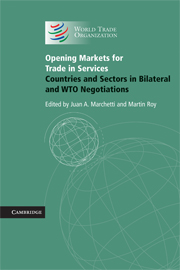Book contents
- Frontmatter
- Contents
- List of figures
- List of tables
- List of boxes
- List of contributors
- Foreword
- Acknowledgments
- Disclaimer
- Summary and overview
- PART I From Policy to Negotiations
- PART II Multilateral and Bilateral Negotiations on Services: Overall Perspectives
- PART III Challenges, Issues and Opportunities in Services Sectors
- PART IV Country Experiences with Services Trade
- 14 GATS plus or minus? Services commitments in comparative contexts for Colombia and Uruguay
- 15 Opening services markets at the regional level under the CAFTA-DR: the cases of Costa Rica and the Dominican Republic
- 16 Why isn't South Africa more proactive in international services negotiations?
- 17 Services liberalization in PTAs and the WTO: the experiences of India and Singapore
- 18 The domestic dynamics of preferential services liberalization: the experience of Australia and Thailand
- 19 The Chilean experience in services negotiations
- Appendix: A reader's guide to basic GATS concepts and negotiations
- Index
Appendix: A reader's guide to basic GATS concepts and negotiations
Published online by Cambridge University Press: 05 December 2011
- Frontmatter
- Contents
- List of figures
- List of tables
- List of boxes
- List of contributors
- Foreword
- Acknowledgments
- Disclaimer
- Summary and overview
- PART I From Policy to Negotiations
- PART II Multilateral and Bilateral Negotiations on Services: Overall Perspectives
- PART III Challenges, Issues and Opportunities in Services Sectors
- PART IV Country Experiences with Services Trade
- 14 GATS plus or minus? Services commitments in comparative contexts for Colombia and Uruguay
- 15 Opening services markets at the regional level under the CAFTA-DR: the cases of Costa Rica and the Dominican Republic
- 16 Why isn't South Africa more proactive in international services negotiations?
- 17 Services liberalization in PTAs and the WTO: the experiences of India and Singapore
- 18 The domestic dynamics of preferential services liberalization: the experience of Australia and Thailand
- 19 The Chilean experience in services negotiations
- Appendix: A reader's guide to basic GATS concepts and negotiations
- Index
Summary
The purpose of this appendix is to provide the reader with an overview of key concepts used in negotiations on trade in services. Many of these concepts find their origin in the WTO General Agreement on Trade in Services, which has served as the model for the services chapters contained in many preferential trade agreements. Reference to other concepts not pertaining to the GATS, but nevertheless necessary to understand other negotiating models, is made whenever appropriate. The appendix also provides an overview of current services negotiations within the WTO Doha Development Agenda.
The appendix is not intended to be an exhaustive explanation or a legal interpretation of the GATS.
What is the GATS?
The WTO General Agreement on Trade in Services entered into force in January 1995 as a result of the Uruguay Round negotiations. It is the first and only multilateral agreement containing rules and disciplines on trade in services. Being part of the Agreement establishing the World Trade Organization, all WTO members are also signatories to the GATS and have to abide by the resulting obligations. As suggested by its Preamble, the GATS aims to encourage the expansion of trade in services under conditions of transparency and progressive liberalization, as a means of promoting economic growth and development.
The scope of the GATS
The GATS applies to all government measures affecting trade in all services sectors, with two exceptions, one sectoral and the other of a more general nature.
- Type
- Chapter
- Information
- Opening Markets for Trade in ServicesCountries and Sectors in Bilateral and WTO Negotiations, pp. 706 - 726Publisher: Cambridge University PressPrint publication year: 2009



